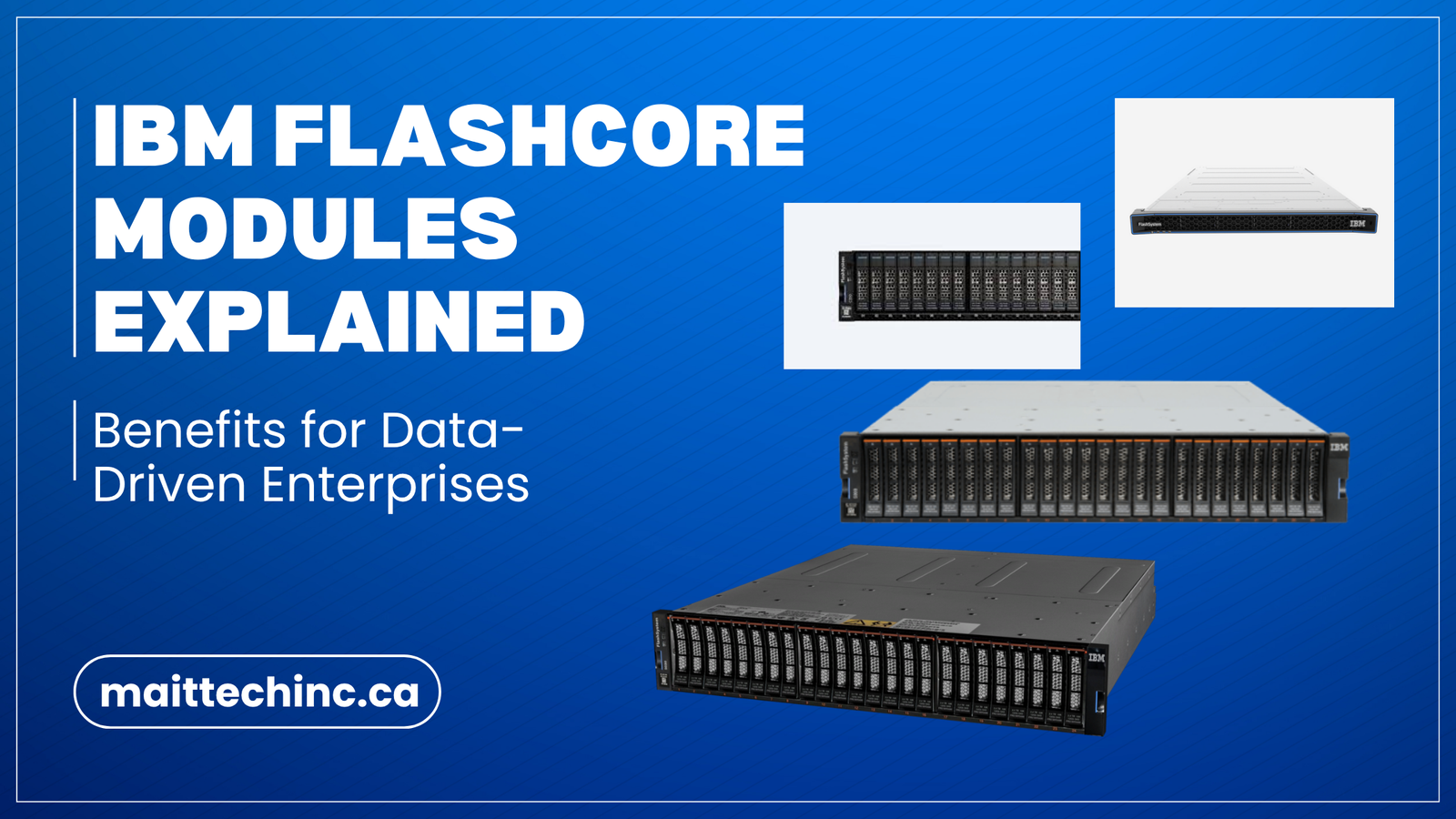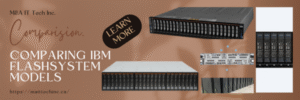Data-driven enterprises are hungry for faster, denser, and more secure storage. IBM’s FlashCore Modules (FCMs) are a cornerstone technology inside IBM FlashSystem arrays that combine NVMe performance, hardware data-reduction, and advanced telemetry — all designed to move heavy analytics, AI and database workloads forward. This deep, Canada-focused guide explains what FCMs are, why they matter to Canadian organisations, shows real Canadian market statistics, and gives practical guidance for evaluating FCMs for your environment.
1. Executive summary (what you’ll learn)
- What an IBM FlashCore Module (FCM) is and how it works.
- Key benefits for data-driven enterprises (performance, density, data reduction, security, ransomware detection).
- Real Canadian market signals that make FCMs relevant today.
- A practical checklist and decision table to evaluate FCMs for your infrastructure.
2. What is an IBM FlashCore Module (short primer)
An IBM FlashCore Module (FCM) is a purpose-built NVMe flash module that IBM engineers and embeds inside its FlashSystem portfolio (and related IBM storage products). FCMs pair high-performance NAND flash hardware with IBM-designed controllers and firmware that provide:
- NVMe-optimized low latency I/O.
- Inline hardware compression and deduplication (data reduction) with minimal CPU overhead.
- Built-in telemetry, analytics and anti-ransomware detection features.
- Tight integration with IBM Storage software for replication, snapshots and management.
Details and product guidance are documented in IBM’s FlashCore product guide and Redpaper materials. IBM Redbooks+1
3. Why FCMs matter to data-driven Canadian organisations - 6 big reasons
- Raw NVMe performance for analytics & AI
FCMs are purpose-tuned for NVMe workloads, significantly reducing I/O latency and increasing IOPS compared with older SAS/SATA flash. For analytics, that means faster query response and reduced time-to-insight. (IBM FlashSystem is engineered around these modules.) IBMcccc - Efficient capacity through inline data-reduction
Hardware compression and deduplication inside FCMs increase effective capacity, often lowering $/GB for active data compared to spinning disk or unoptimized flash. IBM documentation highlights hardware-accelerated inline data reduction as a core FCM advantage. IBM Redbooks - Built-in data security & ransomware detection
Recent FCM iterations include telemetry/ML features to detect anomalous I/O patterns and assist in ransomware detection — useful to enterprises concerned about modern threats. IBM’s Redpaper and product notes outline telemetry and AI/ML-driven detection capabilities. IBM Redbooks+1
4. Canada snapshot: why invest now? (real stats)
Below are a few Canadian and global statistics that show storage demand and the flash/NVMe trend — relevant to procurement timing and ROI calculations.
- Canada data-centre storage market size: valued at approximately USD 936.5 million in 2024 and projected to grow strongly into the decade. Another industry estimate values the Canada data-centre storage market at USD 1.02 billion in 2025, with a projected CAGR near ~11% through 2030. These figures show accelerating domestic demand for storage infrastructure. Verified Market Research+1
- Enterprise flash storage — global context: market estimates put the global enterprise flash storage market in the tens of billions USD in 2024, reflecting rapid enterprise adoption of all-flash arrays and NVMe solutions (multiple market analyses estimate ~USD 22–26B+ for 2024). A growing fraction of Canadian procurement tracks this global trend. Precedence Research+1NVMe market momentum: the NVMe/SSD market is growing fast globally — market research groups report large year-over-year growth in NVMe enterprise SSD adoption, reinforcing why NVMe-native modules like FCMs are strategically important. Straits Research+1
- Canada data-centre storage market size: valued at approximately USD 936.5 million in 2024 and projected to grow strongly into the decade. Another industry estimate values the Canada data-centre storage market at USD 1.02 billion in 2025, with a projected CAGR near ~11% through 2030. These figures show accelerating domestic demand for storage infrastructure. Verified Market Research+1
5. FCM capabilities at a glance — quick comparison table
Capability | Why it matters | Typical business impact |
NVMe-optimized controller | Low latency, high IOPS | Faster analytics queries; lower transaction latency |
Inline hardware compression/dedupe | Better usable capacity | Reduce $/GB for hot data; fewer drives required |
Telemetry & ML ransomware detection | Proactive threat detection | Faster detection/response to anomalous I/O patterns |
Enterprise features (snapshots/replication) | Data services & DR | Easier BC/DR with built-in replication and snapshots |
Dense form factor | More capacity per rack | Lower footprint and power per TB |
Sources: IBM FlashCore product documentation and Redpaper. IBM Redbooks+1
6. Real-world benefits — ROI and operational outcomes (numbered points)
- Faster time-to-insight for analytics
Replacing older storage with FCM-backed arrays often reduces query times and shortens batch/ETL windows — that directly reduces time analysts and data scientists wait, speeding decision cycles.Lower effective storage cost for active datasets
Hardware-accelerated compression and dedupe can increase effective capacity, reducing the number of modules required for active data — which lowers operational costs (power, cooling, and rack space) and delays expensive capacity purchases. - Simplified storage operations
IBM’s tight hardware/software integration reduces tuning overhead and allows storage admins to rely on built-in data services — freeing time for higher value engineering tasks. - Improved resilience & ransomware detection
FCM telemetry and ML models embedded at the module level can detect abnormal I/O earlier than traditional monitoring, improving detection and containment times. - Future-proofing for NVMe workloads
With NVMe becoming the standard for high-performance storage, FCMs position organizations to support next-gen databases, containerized workloads, and AI inference/feature stores.
(Technical and product details from IBM Redpaper and FlashSystem product pages.) IBM Redbooks+1
7. Practical evaluation checklist — should you consider FCMs?
Use this numbered checklist to decide if FCMs are right for your environment:
- Workload profile – Are you running latency-sensitive workloads (databases, analytics, real-time ML inference)? If yes → strong candidate.
- Active dataset economics — Is a large portion of your dataset “active” (frequently accessed) rather than archival? FCMs favor active hot/cold tiers.
- Space/power constraints — Do you need more TB per rack and better power efficiency? FCM density helps.
- Security posture — Do you need advanced telemetry and faster ransomware detection as part of storage? FCMs add telemetry that integrates with IBM Storage Insights. IBM Redbooks+1
Integration needs: Do you use IBM storage software or expect strong integration with IBM FlashSystem features? If so, FCMs are a natural fit. IBM


